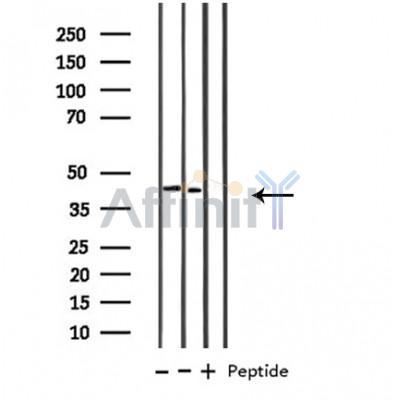B4GALT1 Antibody - #DF3839
| Product: | B4GALT1 Antibody |
| Catalog: | DF3839 |
| Description: | Rabbit polyclonal antibody to B4GALT1 |
| Application: | WB IHC IF/ICC |
| Reactivity: | Human, Mouse |
| Prediction: | Pig, Bovine, Horse, Sheep, Rabbit, Dog |
| Mol.Wt.: | 43 KD; 44kD(Calculated). |
| Uniprot: | P15291 |
| RRID: | AB_2836196 |
Related Downloads
Protocols
Product Info
*The optimal dilutions should be determined by the end user. For optimal experimental results, antibody reuse is not recommended.
*Tips:
WB: For western blot detection of denatured protein samples. IHC: For immunohistochemical detection of paraffin sections (IHC-p) or frozen sections (IHC-f) of tissue samples. IF/ICC: For immunofluorescence detection of cell samples. ELISA(peptide): For ELISA detection of antigenic peptide.
Cite Format: Affinity Biosciences Cat# DF3839, RRID:AB_2836196.
Fold/Unfold
384.Beta-N-acetylglucosaminyl-glycolipid beta-1,4-galactosyltransferase; 4-galactosyltransferase 1; 4-GalTase 1; b4Gal-T1; B4galt1; B4GT1_HUMAN; Beta-1; Beta-N-acetylglucosaminylglycopeptide beta-1,4-galactosyltransferase; Beta4Gal-T1; CDG2D; GGTB2; GT1; GTB; Lactose synthase A protein; N-acetyllactosamine synthase; Nal synthase; Processed beta-1; UDP-Gal:beta-GlcNAc beta-1; UDP-galactose:beta-N-acetylglucosamine beta-1;
Immunogens
A synthesized peptide derived from human B4GALT1, corresponding to a region within C-terminal amino acids.
- P15291 B4GT1_HUMAN:
- Protein BLAST With
- NCBI/
- ExPASy/
- Uniprot
MRLREPLLSGSAAMPGASLQRACRLLVAVCALHLGVTLVYYLAGRDLSRLPQLVGVSTPLQGGSNSAAAIGQSSGELRTGGARPPPPLGASSQPRPGGDSSPVVDSGPGPASNLTSVPVPHTTALSLPACPEESPLLVGPMLIEFNMPVDLELVAKQNPNVKMGGRYAPRDCVSPHKVAIIIPFRNRQEHLKYWLYYLHPVLQRQQLDYGIYVINQAGDTIFNRAKLLNVGFQEALKDYDYTCFVFSDVDLIPMNDHNAYRCFSQPRHISVAMDKFGFSLPYVQYFGGVSALSKQQFLTINGFPNNYWGWGGEDDDIFNRLVFRGMSISRPNAVVGRCRMIRHSRDKKNEPNPQRFDRIAHTKETMLSDGLNSLTYQVLDVQRYPLYTQITVDIGTPS
Predictions
Score>80(red) has high confidence and is suggested to be used for WB detection. *The prediction model is mainly based on the alignment of immunogen sequences, the results are for reference only, not as the basis of quality assurance.
High(score>80) Medium(80>score>50) Low(score<50) No confidence
Research Backgrounds
The Golgi complex form catalyzes the production of lactose in the lactating mammary gland and could also be responsible for the synthesis of complex-type N-linked oligosaccharides in many glycoproteins as well as the carbohydrate moieties of glycolipids.
The cell surface form functions as a recognition molecule during a variety of cell to cell and cell to matrix interactions, as those occurring during development and egg fertilization, by binding to specific oligosaccharide ligands on opposing cells or in the extracellular matrix.
The soluble form derives from the membrane forms by proteolytic processing.
Golgi apparatus>Golgi stack membrane>Single-pass type II membrane protein. Cell membrane>Single-pass type II membrane protein. Cell surface. Cell projection>Filopodium.
Note: Found in trans cisternae of Golgi but is mainly localized at the plasma membrane (PubMed:1714903). B4GALT1 cell surface expression is regulated by UBE2Q1 (By similarity).
Golgi apparatus>Golgi stack membrane>Single-pass type II membrane protein.
Note: Found in trans cisternae of Golgi.
Secreted.
Note: Soluble form found in body fluids.
Ubiquitously expressed, but at very low levels in fetal and adult brain.
Belongs to the glycosyltransferase 7 family.
Research Fields
· Metabolism > Carbohydrate metabolism > Galactose metabolism.
· Metabolism > Glycan biosynthesis and metabolism > N-Glycan biosynthesis.
· Metabolism > Glycan biosynthesis and metabolism > Other types of O-glycan biosynthesis.
· Metabolism > Glycan biosynthesis and metabolism > Glycosaminoglycan biosynthesis - keratan sulfate.
· Metabolism > Glycan biosynthesis and metabolism > Glycosphingolipid biosynthesis - lacto and neolacto series.
· Metabolism > Global and overview maps > Metabolic pathways.
Restrictive clause
Affinity Biosciences tests all products strictly. Citations are provided as a resource for additional applications that have not been validated by Affinity Biosciences. Please choose the appropriate format for each application and consult Materials and Methods sections for additional details about the use of any product in these publications.
For Research Use Only.
Not for use in diagnostic or therapeutic procedures. Not for resale. Not for distribution without written consent. Affinity Biosciences will not be held responsible for patent infringement or other violations that may occur with the use of our products. Affinity Biosciences, Affinity Biosciences Logo and all other trademarks are the property of Affinity Biosciences LTD.


